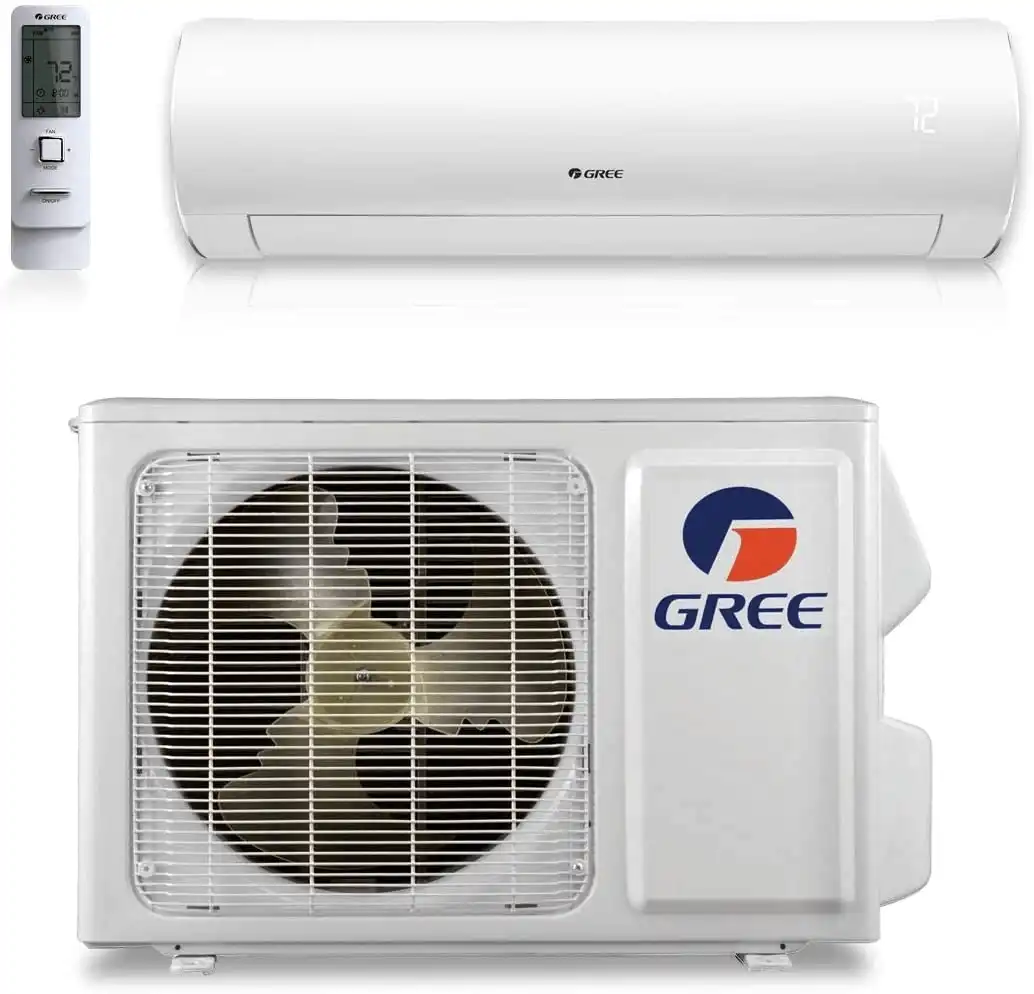
Mini-Split vs Central Air: Which Is Quieter?
For HVAC contractors and homeowners alike, noise levels can make or break the comfort provided by an HVAC system. Whether it's a restful night's sleep, a productive work environment, or a peaceful living space, the quiet operation of your heating and cooling system is essential. When comparing mini-split systems to central air, understanding their noise profiles can help you make the right recommendation or investment.
A noisy system can lead to dissatisfaction, complaints, and even costly service calls. This article provides a detailed comparison of mini-splits and central air systems, focusing on their noise levels, design features, and installation tips. By the end, you'll have a clear understanding of which system is best for noise-sensitive areas like bedrooms, offices, and living spaces. Let's dive in and explore the quieter solution for your HVAC needs.
Use the System Builder tool to explore zoning options for noise-sensitive projects.
Mini-Split System Noise Levels
Mini-split systems are known for their quiet operation, making them a perfect choice for bedrooms, home offices, and other spaces where minimal noise is a priority.
Decibel Ratings for Indoor and Outdoor Units
Indoor units of mini-split systems typically produce sound levels between 25 and 35 decibels. To put that in perspective, 25 dB is as quiet as a whisper or the stillness of a library, while 35 dB is akin to the faint hum of a peaceful suburban evening. Some advanced GREE models, such as the SAPPHIRE series, operate as quietly as 20 dB indoors, delivering near-silent comfort.
Outdoor units are equally impressive. For example, GREE outdoor units, like the MULTI21+ series, operate around 30–38 dB, ensuring minimal disturbance even in residential neighborhoods.
In comparison, central air systems are significantly louder, typically ranging from 50 to 75 dB. The quiet performance of mini splits is made possible by smart engineering, which we'll explore next.
Design Features That Reduce Noise
Several design elements contribute to the near-silent operation of mini-split systems. By eliminating ductwork, GREE ductless mini-splits avoid pressure losses, rattling, and airflow noise common in traditional central systems.
Inverter technology plays a big role by allowing the system to adjust its capacity smoothly, avoiding the loud startup noises typical of older systems. Additionally, multi-speed fans and dedicated "quiet modes" ensure the unit runs at lower speeds when full cooling power isn't needed.
"No, nothing like that. The compressor will be located outside while the fan will be situated inside. You'll hear the fan running when it blows cold air, but that's all." – Brandon B, HVAC Technician
Other noise-reducing features include sound-dampening materials and advanced compressor designs, which minimize vibrations and operational noise.
Installation Tips for Noise Reduction
Proper installation is just as important as design when it comes to keeping mini-split systems quiet. For indoor units, avoid placing indoor units directly above beds or workstations. Maintain a clearance of 6–8 inches above the unit and 12 inches on the sides for service access, as per IMC §1105.
Outdoor units should be positioned thoughtfully as well. Place outdoor units on a stable pad, maintaining 3 ft (36 in) clearance in front and 12–24 inches on the sides/rear per IMC §1101.10 and NEC 110.26. Use vibration-isolating pads or mounts to reduce noise transmission. Placing the unit at least 10 feet away from bedroom windows or outdoor seating areas also ensures its low sound levels remain undetectable.
To further reduce noise, use vibration-isolating techniques during installation. This includes mounting the outdoor unit on a stable, level surface with rubber pads or vibration-dampening mounts. Ensuring refrigerant lines are properly secured and insulated can also prevent rattling and improve energy efficiency.
GREE Comfort's mini-split systems are a great example of these principles in action. Designed for both single-zone and multi-zone setups, their ductless systems eliminate the noise issues associated with traditional ductwork while delivering whisper-quiet operation. These thoughtful design and installation practices highlight why mini-splits are an excellent choice for anyone prioritizing a peaceful, quiet environment.
Central Air System Noise Levels
Central air systems tend to be noisier than mini-split systems due to their larger components and extensive ductwork. Knowing where the noise comes from can help contractors manage expectations and find ways to reduce sound levels effectively.
What Causes Noise in Central Air Systems
One major source of noise in central air systems is the air handler or furnace. The blower motor in the air handler, combined with the movement of air through long ductwork, often creates a steady hum or whooshing sound. Air traveling at high speeds through metal ducts can cause turbulence, and if the ducts have sharp bends, restrictions, or are poorly secured, vibrations can occur, amplifying the noise further.
The outdoor compressor unit also adds to the noise. Since central air systems are designed to cool entire homes, their compressors operate more noticeably, cycling on and off with distinct startup and shutdown sounds. Additionally, air being forced through narrow or restricted duct spaces can produce whistling or rushing noises throughout the home. This is a notable difference from mini-split systems, which house most noise-producing components outside the living space.
Average Noise Levels in Central Air Systems
Central air systems typically produce noise levels ranging from 50 to 80 decibels. For context, 50 dB is similar to the sound of gentle rainfall, while 80 dB is comparable to a running garbage disposal. Systems that are well-designed and regularly maintained generally operate on the quieter end of this spectrum. In contrast, older or poorly maintained systems may reach the upper end of the range.
How to Reduce Central Air Noise
Reducing noise in central air systems starts with regular maintenance. Simple tasks like replacing air filters on time and lubricating moving parts can significantly cut down on unwanted sounds. Insulating and securely fastening ductwork also helps minimize vibrations and reduces the spread of noise through the home.
Modern central air systems often come equipped with variable-speed compressors and smart controls, which adjust their operation based on cooling needs. Similar to the inverter technology in mini-splits, these variable-speed compressors allow for smoother, quieter operation by avoiding abrupt starts and stops. Placing outdoor units away from bedrooms or outdoor living areas can further reduce perceived noise.
For example, GREE Comfort's central air systems like the FLEXX Series incorporate advanced compressor technology and smart controls to provide efficient cooling while keeping operational noise to a minimum. These thoughtful design features make a noticeable difference in maintaining a quieter home environment.
Direct Noise Comparison
When contractors need to provide recommendations for HVAC systems, having clear noise data is essential. This information allows them to align system choices with the specific needs and preferences of their clients.
Noise Level Comparison Table
Here's a side-by-side look at how mini-split and central air systems compare in terms of noise performance:
| Factor | Mini-Split Systems | Central Air Systems |
|---|---|---|
| Indoor Unit Noise | Extremely quiet, producing minimal indoor sound | Noticeable background noise during operation |
| Outdoor Unit Noise | Compact compressor and fan designed to minimize outdoor noise (typically operates at 30–40 dB) | Louder due to larger compressors and ventilation needs (central air compressors range 50–75 dB, depending on size and load) |
| Primary Noise Sources | Compressor and fan, designed for quiet operation | Air handler blower, duct airflow, and a larger compressor |
| Bedroom Impact | Near-silent, ideal for bedrooms | May create a steady background noise that could disturb sensitive areas |
| Living Area Impact | Maintains a quiet background ambiance | Produces consistent noise across the conditioned space |
| Outdoor Impact | Noise is mostly confined to the immediate area | Larger components can spread noise over a wider area |
This comparison can serve as a valuable guide when tailoring HVAC system recommendations to your clients' specific priorities.
How to Use Noise Data for Client Recommendations
Understanding a client's sensitivity to noise early in the consultation process is key. For example, light sleepers, remote workers, or families with infants often prefer quieter systems. Mini-split systems are particularly well-suited for noise-sensitive areas like bedrooms, home offices, and nurseries. Additionally, positioning outdoor units away from high-traffic or frequently used areas can further enhance comfort.
GREE's SAPPHIRE, VIREO+, and MULTI21+ mini-splits stand out for their advanced inverter technology and precision engineering, ensuring quiet operation both indoors and outdoors. Their single-zone and multi-zone options allow for targeted comfort without disrupting the peace of a home.
In general, mini-split systems are quieter than central air systems, making them an excellent choice for clients who value a calm and relaxing environment.
Factors That Affect HVAC Noise
The design of mini-split and central air systems plays a big role in how noisy or quiet they are, but external factors can also make a huge difference in their performance. Knowing these variables can help contractors provide better recommendations and ensure their clients enjoy a quieter system. These factors range from installation practices to ongoing maintenance and even building characteristics.
Installation and Maintenance Quality
The way an HVAC system is installed can make or break its noise performance. Even the quietest system can turn disruptive if not installed correctly. For mini-splits, improper mounting can amplify vibrations, while outdoor units that aren't leveled or secured properly may rattle over time. Ensure indoor units are securely mounted to studs and outdoor units are level on solid pads. Follow NEC 110.26 for service clearance and IMC 1101.10 for airflow spacing.
Central air systems, with their complex ductwork, are even more sensitive to installation quality. Poorly installed ductwork can increase noise and force the system to work harder. Similarly, air handlers that aren't securely mounted can transmit vibrations throughout the building.
Maintenance is just as important. Dirty filters, for instance, cause fans to run at higher speeds, increasing noise levels. Mini-splits with dusty evaporator coils lose efficiency, leading to longer cycles and more noise. Central air systems with clogged filters experience restricted airflow, which not only makes them louder but can also strain the system.
Refrigerant levels also play a role. When refrigerant is low, compressors have to work harder, which raises noise levels. This applies to both mini-splits and central air systems, making professional maintenance a must for keeping them running quietly.
Building and Location Factors
The structure and layout of a building can change how HVAC noise is heard and distributed. Hard surfaces like tile floors, bare walls, and hardwood reflect sound, making systems seem louder. On the other hand, carpeting, curtains, and upholstered furniture absorb sound, helping to minimize noise.
Room size and ceiling height also matter. Smaller rooms with low ceilings can make even quiet mini-split units seem louder, while larger rooms with high ceilings help diffuse sound. Open floor plans tend to let central air system noise travel throughout the space, while homes with more compartmentalized layouts can contain noise in specific areas. This highlights the importance of thoughtful system placement.
The location of outdoor units is another key factor. For example, central air condensers, which are larger and louder, need careful placement to minimize their impact on both homeowners and neighbors. Solid foundations, like concrete, are ideal for stabilizing outdoor units and reducing vibration. Use solid concrete pads with rubber vibration isolators to prevent noise transfer and prolong compressor life. In contrast, wooden decks or elevated platforms can amplify vibrations unless properly isolated with rubber pads or vibration dampeners.
Smart Controls and Zoning for Noise Reduction
Technology can also help manage HVAC noise. Modern smart controls allow for precise adjustments that go beyond basic thermostats. These systems can automatically adjust fan speeds and use variable-speed operation to keep noise levels low while maintaining comfort. This is particularly effective with mini-split systems, which are naturally quieter than central air.
GREE Comfort's smart controls add another layer of noise management by offering customizable modes that prioritize quiet operation. For example, systems can lower fan speeds during designated quiet hours or when motion sensors detect inactivity in certain areas. This ensures comfort without disrupting peace and quiet.
Zoning capabilities also help reduce noise by allowing different parts of the home to operate independently. For instance, GREE's multi-zone systems can keep bedrooms at a comfortable temperature without running the entire HVAC system, which is especially useful during nighttime hours.
Occupancy sensors integrated with smart controls take this a step further by detecting when rooms are empty and adjusting operation accordingly. This feature is particularly helpful for clients who work from home or have irregular schedules, as it minimizes noise in active areas while maintaining comfort.
Conclusion: Choosing the Quieter HVAC System
When evaluating noise performance, mini-split systems stand out compared to traditional central air conditioning. This difference in sound levels can greatly influence your clients' comfort and satisfaction with their HVAC system, making it a crucial factor to consider.
Key Takeaways from the Noise Comparison
Mini-split systems typically operate at sound levels between 25–35 dB, comparable to the hushed ambiance of a library, while central air systems range from 50 to 75 dB, similar to the noise of common household appliances. Some advanced mini-split models even achieve impressively low noise levels of 20–22 dB.
One of the primary reasons for this quieter performance is the ductless design of mini-splits, which relocates the noisier components outdoors. In contrast, central air systems depend on ductwork, and their noise levels can be impacted by the quality of the ducts and the need for regular maintenance.
For contractors, these insights highlight the benefits of recommending mini-split systems to clients who prioritize quiet operation. This is particularly relevant for spaces like bedrooms, home offices, or other areas where minimal noise is essential.
GREE Comfort Solutions for Noise Reduction
GREE Comfort offers mini-split and central air systems designed with advanced inverter technology and smart controls to keep noise levels low. Their MultiPRO systems, for example, can support up to 10 zones while maintaining quiet indoor operation. Additionally, their central air units are built for energy efficiency and reduced noise during operation.
Smart features take noise management a step further, with customizable quiet modes and occupancy sensors that adjust system activity when rooms are unoccupied.
For personalized recommendations, explore the System Builder tool and watch instructional resources.
FAQs
Why are mini-split systems quieter than central air systems?
Mini-split systems are known for their quiet operation, thanks to a few standout features. One of the main reasons is their use of inverter-driven compressors, which adjust speed based on the specific heating or cooling needs. This adaptability not only improves efficiency but also keeps noise levels low. Another advantage is that the outdoor unit of a mini-split is typically installed away from indoor spaces, meaning the sound it generates is less noticeable inside your home. On top of that, many models are equipped with sound-dampening technology and specially designed fans to ensure even quieter performance.
On the other hand, central air systems can be noisier. They often rely on larger, fixed-speed compressors and ductwork, which can amplify sound as air moves through the ducts. For anyone prioritizing a quieter and more peaceful indoor environment, mini-splits are a popular choice, especially in areas where minimizing noise is important.
How does the placement of outdoor units affect the noise levels of mini-split and central air systems?
The location of outdoor units significantly impacts the noise levels of both mini-split and central air systems. For mini-splits, placing the outdoor unit away from walls, corners, or other hard surfaces is ideal, as these can amplify noise and vibrations. Install outdoor units with 12–24 in. side/rear and 36 in. front clearance per IMC §1101.10. Avoid corners to reduce echo and use vibration pads on concrete pads for stability.
In the case of central air systems, proper airflow is key. Positioning the unit in an open space, free from obstructions, helps minimize noise while maintaining efficient performance. While barriers like fences or shrubs can help reduce sound, it's important to ensure they don't obstruct airflow. Careful placement of outdoor units is essential for keeping noise levels manageable in both types of systems.
How can I maintain mini-split and central air systems to keep them running quietly over time?
To keep your mini-split or central air system running quietly, consistent maintenance is essential. Clean or replace filters every 1-3 months for mini-split and at least once a month for central air systems as per maintenance guidelines, and schedule annual tune-ups. This simple step prevents debris buildup, which can strain the system and lead to increased noise.
It's also important to check the outdoor unit regularly. Clear away dirt, leaves, or other debris that might obstruct airflow or cause vibrations. For mini-splits, pay attention to the indoor unit - dust on the blower or coils can impact both performance and noise levels. With central air systems, ensure the ductwork is properly sealed and insulated to reduce sound transmission.
Finally, scheduling a professional tune-up at least once a year can catch potential problems early. A thorough inspection helps address issues before they grow, ensuring your system operates efficiently and quietly over time.




